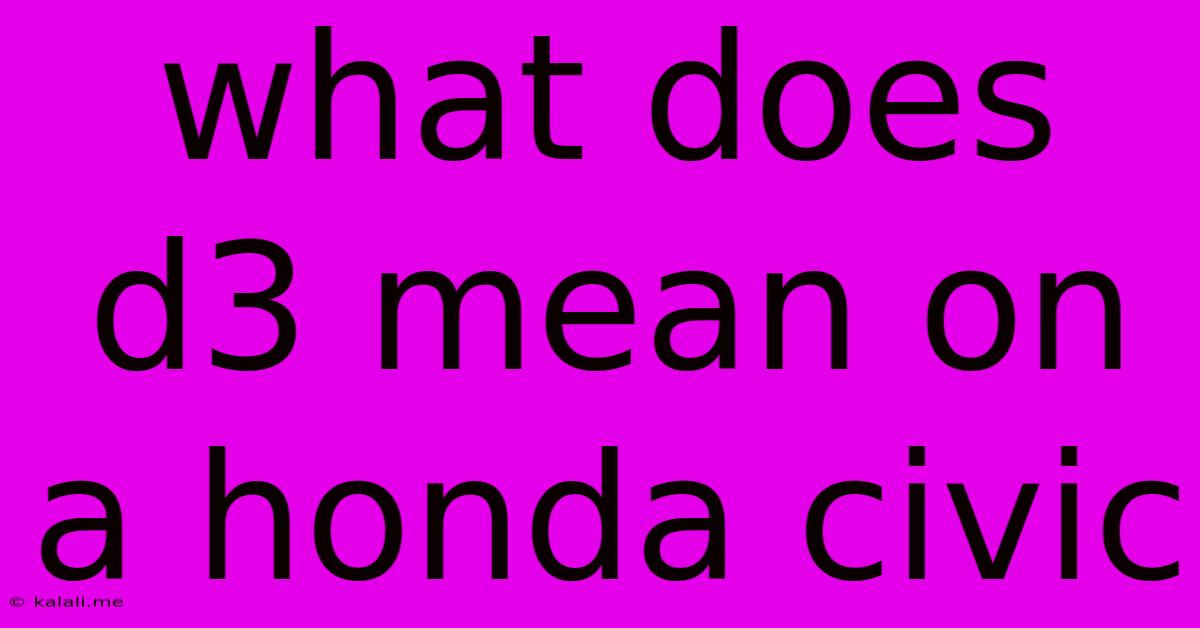What Does D3 Mean On A Honda Civic
Kalali
May 31, 2025 · 3 min read

Table of Contents
What Does D3 Mean on a Honda Civic? Understanding Your Car's Transmission
The appearance of "D3" on your Honda Civic's transmission display can be confusing if you're not familiar with its function. This article will explain what D3 means, when to use it, and how it differs from other drive modes. Understanding this will improve your driving experience and potentially extend the life of your transmission.
Understanding Honda Civic Transmission Modes
Honda Civics, depending on the model and year, feature various drive modes displayed on the dashboard. These modes control how the automatic transmission shifts gears, affecting acceleration, fuel efficiency, and engine performance. Common modes include:
- D (Drive): This is the standard driving mode. The transmission automatically shifts through all gears based on throttle input and speed.
- 2 (Second Gear): Limits the transmission to only use first and second gear, providing increased engine braking on steep descents.
- L (Low Gear): This mode utilizes the lowest gears, providing maximum engine braking and is ideal for steep hills or towing.
- D3 (Third Gear): This is where the focus lies. It restricts the transmission to using only the first three gears.
What D3 Means and When to Use It
D3, or third gear, on your Honda Civic's automatic transmission limits the transmission to only use the first three gears. This results in more engine braking and slower acceleration. It's primarily designed for specific driving situations where maintaining a lower gear is advantageous. Here are some key scenarios:
- Descending Steep Hills: D3 provides significant engine braking, helping to control your speed and reduce strain on your brakes, especially during long descents. This is crucial for safety and preventing brake overheating. This is probably the most common use case.
- Towing Light Loads: While not ideal for heavy towing, D3 can be helpful when towing a relatively light trailer or caravan, offering more control and reducing the load on the transmission.
- Improved Engine Braking in Challenging Conditions: Muddy or icy roads can benefit from the increased engine braking provided by D3, enhancing control and stability.
D3 vs. Other Drive Modes: Key Differences
While D3 shares similarities with the "2" and "L" modes, there are subtle yet important differences:
- D3 vs. 2: D3 allows for the use of three gears, compared to only two in mode "2." This gives you more flexibility, allowing for slightly higher speeds while still providing effective engine braking.
- D3 vs. L: L mode utilizes the lowest gears, often resulting in lower speeds and more pronounced engine braking. D3 offers a middle ground, providing a balance between engine braking and usable speed.
Important Considerations:
- Not for Everyday Driving: Constantly using D3 for everyday driving is not recommended. It can lead to increased engine wear and lower fuel efficiency.
- Consult Your Owner's Manual: Always refer to your vehicle's owner's manual for specific recommendations and guidelines related to using the different transmission modes.
By understanding the function of D3 on your Honda Civic, you can use this valuable tool to improve your driving safety and control in challenging situations. Remember, it's a feature designed for specific conditions, and utilizing it wisely contributes to a safer and more efficient driving experience.
Latest Posts
Latest Posts
-
Blender Gradient Tool Front Faces Only
Jun 02, 2025
-
How To Fix A Bike Tire
Jun 02, 2025
-
What Does Oro Mean In Japanese
Jun 02, 2025
-
How To Change Notification Sound On Messenger Android
Jun 02, 2025
-
Freezing Point For Water In Kelvin
Jun 02, 2025
Related Post
Thank you for visiting our website which covers about What Does D3 Mean On A Honda Civic . We hope the information provided has been useful to you. Feel free to contact us if you have any questions or need further assistance. See you next time and don't miss to bookmark.